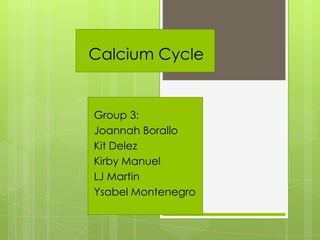Calcium cycle
•Descargar como PPT, PDF•
4 recomendaciones•13,196 vistas
Envi. Sci. Handouts. \m/
Denunciar
Compartir
Denunciar
Compartir

Recomendados
Recomendados
Más contenido relacionado
La actualidad más candente
La actualidad más candente (20)
Soil Organisms, functions and their role in Soil fertility

Soil Organisms, functions and their role in Soil fertility
Root Exudates :Functions in plant-microbe interaction

Root Exudates :Functions in plant-microbe interaction
Soil science- soil & fertilizer nitrogen , forms , mineralization , immobali...

Soil science- soil & fertilizer nitrogen , forms , mineralization , immobali...
Destacado
Destacado (20)
Lab.11 methods for estimating denitrification process

Lab.11 methods for estimating denitrification process
Similar a Calcium cycle
B.Sc III Chemistry 1. B.Sc III Essential and non essential element.pptx

1. B.Sc III Essential and non essential element.pptxDept of chemistry,Shri Shivaji Science College,Amravati
The Indian Dental Academy is the Leader in continuing dental education , training dentists in all aspects of dentistry and offering a wide range of dental certified courses in different formats.
Indian dental academy provides dental crown & Bridge,rotary endodontics,fixed orthodontics,
Dental implants courses.for details pls visit www.indiandentalacademy.com ,or call
0091-9248678078Calcium&phosphorus metabolisam in growth /certified fixed orthodontic courses...

Calcium&phosphorus metabolisam in growth /certified fixed orthodontic courses...Indian dental academy
Similar a Calcium cycle (20)
Calciummetabolism 150129022239-conversion-gate01-converted-converted

Calciummetabolism 150129022239-conversion-gate01-converted-converted
1. B.Sc III Essential and non essential element.pptx

1. B.Sc III Essential and non essential element.pptx
Calcium&phosphorus metabolisam in growth /certified fixed orthodontic courses...

Calcium&phosphorus metabolisam in growth /certified fixed orthodontic courses...
Más de Maurice
Más de Maurice (6)
Calcium cycle
- 1. Calcium Cycle Group 3: Joannah Borallo Kit Delez Kirby Manuel LJ Martin Ysabel Montenegro
- 2. What is Calcium? Calcium is the chemical element with the symbol Ca and atomic number 20. It has an atomic mass of 40.078 amu. Calcium is a soft gray alkaline earth metal, and is the fifth most abundant element by mass in the Earth's crust. Calcium is also the fifth most abundant dissolved ion in seawater by both molarity and mass, after sodium then chloride, magnesium, and sulfate.
- 3. Importance of Calcium in Life Calcium is necessary for life In early life, calcium helps build strong bones and teeth Helps with muscle contraction and other body process Plants need calcium to help in cell wall development and their metabolism; stronger cell walls protect from pathogens
- 4. Calcium in human bodies From birth to death calcium is an essential element for human beings. Besides its presence in bones and teeth, the mineralized tissues which contain 99% of the body’s calcium, it is present in ionized form in the blood, extracellular fluids and within the cells of soft tissues such as muscles. It is necessary for the release of energy in muscular contraction, for nerve transmission and the regulation of heart beat, must be present for blood to clot, and influences the transport function of cell membranes. The proper balance of calcium with sodium, potassium and magnesium ions maintains muscle tone and controls irritability.
- 5. From the biosphere… Calcium enters from biosphere in dust or from organisms Like phosphorous, there is no gaseous state so it does not stay in the atmosphere When animals die, the calcium in their bodies are decomposed and go into soil In the soil… Water can carry calcium to or from soil through weathering When in the soil, calcium is in an insoluble form until it is broken down by microbes into a usable form Mineralization can store calcium in rocks Calcium can be returned from root leakage Calcium can be absorbed by plant roots
- 6. In plants… When absorbed by plants, calcium is now in an organic state The calcium can continually be recycled between the plant roots and soil Or herbivores can eat the plants or drink the water and the calcium returns to the biosphere If the plant or animal dies, decomposers break down the organism and calcium is returned to water or soil
- 8. Occurrence Calcium is not naturally found in its elemental state. Calcium occurs most commonly in sedimentary rocks in the minerals calcite, dolomite and gypsum. It also occurs in igneous and metamorphic rocks chiefly in the silicate minerals: plagioclase, amphiboles, pyroxenes and garnets.
- 9. The End
